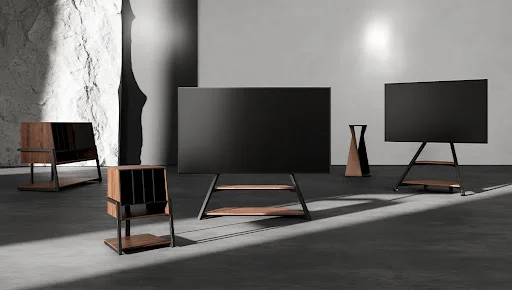The right TV stand size should be a few inches wider than your TV, tall enough to place the screen at eye level, and sturdy enough to support its weight. This ensures a safe, balanced, and comfortable viewing setup. In this guide, you’ll find a quick size chart, practical tips, and answers to common questions to help you choose the perfect fit.
Loved this? Our related post takes you one step further—check it out!
Why TV Stand Size Matters
A properly sized stand ensures:
- Safety: Your TV sits securely without risk of tipping.
- Proportion: The stand and TV look balanced in the room.
- Comfort: The screen is positioned at the correct viewing height.
- Functionality: Enough space for devices, décor, and cable management.
Brands like FITUEYES design their tv stand collections with these principles in mind, combining stability, proportion, and modern style to enhance different types of living spaces.
TV Size vs. Recommended Stand Width (Quick Chart)
| TV Size (Diagonal) | Approx. TV Width | Recommended Stand Width |
| 50-inch TV | ~44 inches | 47–55 inches |
| 55-inch TV | ~48 inches | 50–60 inches |
| 65-inch TV | ~57 inches | 60–70 inches |
| 75-inch TV | ~65 inches | 68–80 inches |
| 85-inch TV | ~74 inches | 80–90 inches |
Tip: Aim for a stand that is at least 2–3 inches wider on each side of your TV.
How to Choose the Right TV Stand Size
Measure Your TV Properly
When buying a stand, don’t rely only on the TV’s advertised size. TV sizes (like 55-inch or 65-inch) are measured diagonally across the screen, not by the actual width. To get the right stand, you’ll need the real width, height, and sometimes the depth of your TV.
Here’s how to measure:
- Width: Use a tape measure to check the horizontal distance across the screen, from the left edge of the bezel to the right edge.
- Height: Measure from the bottom of the TV (or stand legs) to the top edge of the bezel.
- Depth: If your TV has a stand base or legs, measure from the front edge of the base to the back edge to ensure your furniture is deep enough.
Where to find accurate specs:
- Manufacturer’s Website: Look up your TV model number online. Most product pages list exact width, height, depth, and weight.
- User Manual: Check the dimensions section in the manual that came with your TV.
- Retailer Product Page: Major retailers often include product dimensions alongside the TV description.
Always double-check the weight of your TV too, and compare it with the stand’s weight capacity to make sure it’s safe.
Width of the Stand
- Choose a stand that’s wider than your TV for balance and safety.
- Reference the chart above for easy guidance.
Height of the Stand
- The TV’s screen center should sit at eye level when seated — usually 42–48 inches from the floor.
- Adjust based on sofa or chair height.
Depth and Stability
- Ensure the stand depth can support the TV base or legs.
- Pick sturdy materials like solid wood or metal for durability.
Additional Considerations
Room Size and Layout
- Small rooms → choose compact stands.
- Large rooms → wider stands balance the space.
Storage and Functionality
- Decide if you need shelves, drawers, or cabinets for consoles, speakers, or media.
- Closed storage hides clutter; open shelving keeps items accessible.
Style and Aesthetic
- Match the finish with existing furniture.
- Minimalist designs suit modern spaces; wood tones suit classic interiors.
Wall-Mounted vs. Stand Placement
- Wall mounts save floor space but limit storage.
- A tv stand from FITUEYES offers storage, balance, and flexible placement, blending practical features with design aesthetics.
Practical Tips Before You Buy
- Use Floor Tape: Outline the stand’s dimensions on the floor to visualize fit.
- Plan for the Future: Buy a stand slightly wider if you expect to upgrade your TV size.
- Check Cable Management: Look for stands with built-in channels or holes for neat wiring.
Frequently Asked Questions
Q: Can I put a 65-inch TV on a 55-inch stand?
A: Not recommended — the TV will overhang, look unbalanced, and may be unsafe. Always pick a stand equal to or wider than the TV.
Q: What is the ideal viewing height?
A: The center of the screen should be at eye level, about 42–48 inches from the floor.
Q: How do I know if a stand can hold my TV?
A: Check the stand’s weight capacity in the product specs and compare it to your TV’s weight. Always allow for a safety margin.
Q: Can I use a dresser or sideboard instead of a TV stand?
A: Yes, if the surface is wide, deep, and sturdy enough. For large or heavy TVs, a purpose-built stand is safer.
Q: Do TV stands come with anti-tip features?
A: Many modern stands are designed for stability. For extra security with children or pets, add wall anchors or anti-tip straps.
Final Thoughts
The right TV stand size is about more than just inches — it’s about safety, comfort, and how your living space feels. Brands like FITUEYES design stands that not only fit your TV but also elevate the overall look of your home. Use the size chart as a quick reference, measure carefully, and plan for your room’s layout and style. With the right choice, your setup will look balanced and feel effortless.
Don’t stop here—click to explore more content tailored to your lifestyle.







